
NPAC 2014 Proceedings_final
.pdf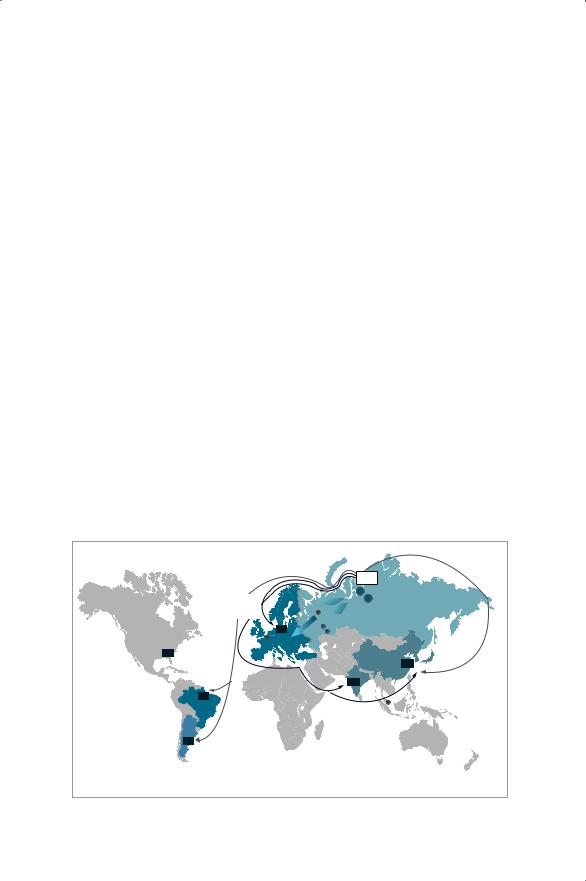
104 |
Patterns of Arctic Investment |
MOL. The first vessel is expected to be completed in March 2018. |
|
|
DSME gave notice of acknowledgement of orders to build nine ARC7 |
ice-class LNG carriers this time. These vessels will be delivered by the end of February 2020. The six LNG carriers other than those ordered by the joint venture company of MOL and China Shipping are supposed to be ordered by Teekay LNG Partners LP (USA). In addition, one ARC7 iceclass LNG carrier was already ordered by Sovcomflot (a Russian stateowned company) in March 2014 and will be delivered by the end of June 2016. Since it is expected that 15-16 specialized LNG carriers (around five carriers per LNG train) are needed for all-year constant shipping of LNG from Sabetta Port, around two-thirds of them have been ordered from DSME.
All ARC7 LNG carriers now built or contracted for building will serve under a time-charter contract with Yamal LNG, of which the shareholders are Novatek (Russia, 60%), Total (France, 20%) and CNPC (China, 20%). The contract period of the time-charter is 25 years. Under the time-charter contract, the ARC7 ice-class LNG carriers operated by MOL will transport LNG to any destination that the customer (i.e., Yamal LNG Project) instructs. From Sabetta Port, operation to Europe will be conducted all year long, with operation to East Asia, including China, Japan and Korea via the NSR being possible only during the summer season (for example, from May to November) as shown in Figure I-11.
|
|
|
LNG |
|
|
|
|
|
YAMAL |
|
|
|
|
|
TRADE |
15~30 |
|
|
|
|
YAMAL LNG |
Russian |
|
European |
|
|
|
|
|
|
|
NOVATEK |
domestic gas |
||
|
|
|
|
||
gas market |
|
Mosk |
Pipeline |
|
market |
|
9 ? |
|
gas |
|
|
|
|
NOVATEK PERM |
|
|
|
|
|
NOVATEK CHELYABNSK |
|
||
NOVATEK |
EUROPE |
|
|
|
|
|
|
|
|
|
|
EUROPE |
|
|
|
|
|
3.6 |
|
|
|
|
|
|
|
|
|
|
12.1 ASIA |
?????? |
|
|
INDEA12.4 |
|
Asian |
12 |
|
|
|
|
gas market |
|
|
|
|
|
|
|
|
|
NOVATEKsingapor |
|
|
|
|
|
ASIA |
|
|
12 |
|
|
|
|
|
?????? |
|
|
|
|
|
Source: Yamal LNG http://www.novatek.ru/en/investors/presentations/index.php?quarter_5=2
Figure I-11. Expected importers of Yamal LNG and shipping routes
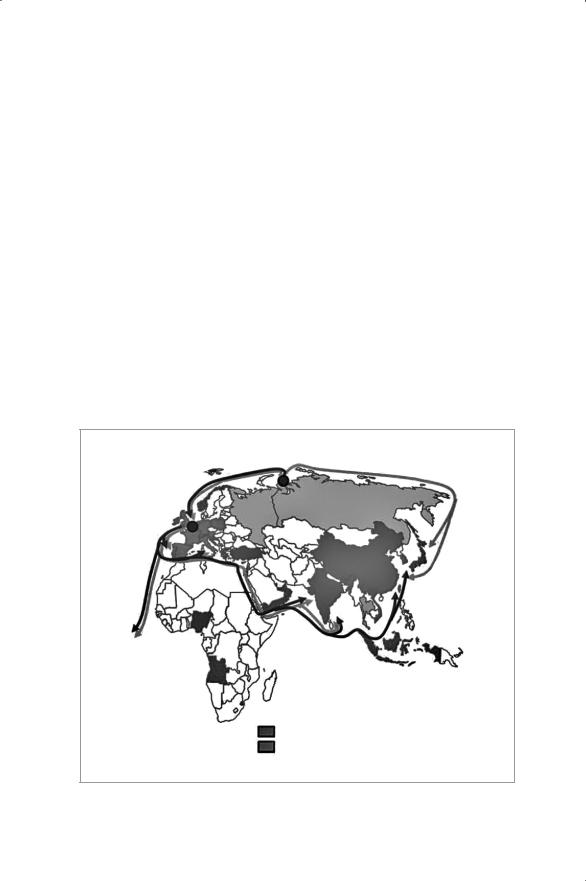
Commentaries |
105 |
TRANSSHIPMENT HUB OF LNG
According to a press release4 issued on May 20, 2014 by Yamal LNG, a binding contract with CNPC to provide for the supply of three million tons of LNG per annum at delivered ex-ship (DES) terms, including delivery cost by maritime shipping for a period of 20 years, has been concluded. In addition, in order to provide year-round supply to East Asia, Yamal LNG has signed an agreement outlining the parameters of cooperation on the transshipment of LNG with Fluxys, which is a Belgium-based, fully independent gas infrastructure group, according to a press release issued on April 4, 2014. The Zeebrugge LNG terminal, which is owned by Fluxys LNG, a 100% affiliate of Fluxys, will be the transshipment platform enabling LNG supply from Yamal to the Asian-Pacific countries when winter navigation is closed on the Arctic Ocean’s NSR (see Figure I-12). Fluxys will carry out all technical, permitting and regulatory processes with a view to provide LNG transshipment services.
Winter route |
Yamal LNG |
|
|
Trans- |
|
shipment |
|
South
America
Summer route
 LNG exporters
LNG exporters
 LNG importers
LNG importers
Source: Total, Yamal LNG
Figure I-12. Yamal LNG shipping options with transshipment in Europe to East Asia during the winter season
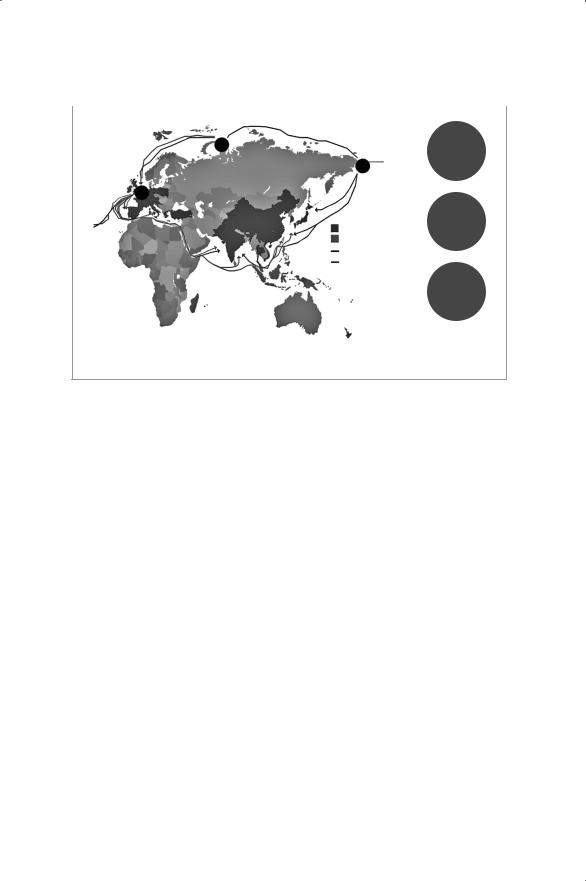
106 |
Patterns of Arctic Investment |
|
||
|
|
|||
YAMAL LNG EXPORT ROUTES |
',$+c |
|||
|
|
|
|
|
|
|
|
|
tonnes Yamal |
|
Sabetta |
annual production |
||
|
capacity |
|||
|
|
|
|
|
|
|
|
transhipment |
2018-2019 |
|
|
|
|
|
transhipment |
|
|
|
|
|
|
|
|
'+#(& |
|
|
|
|
LNG carrier loads |
|
|
|
LNG market |
Yamal will require |
|
|
|
per month |
|
|
|
|
||
|
|
|
LNG exporter |
2018-2019 |
|
|
|
||
|
|
|
summer route |
|
|
|
|
|
|
winter route
*&$(c
cu m monthly gas exports from Yamal
in 2018-2019
source: Lloyd’s List Intelligence: http://info.lloydslistintelligence.com/yamal-lng-puts-russian-gas-on- the-map/
Figure I-13. Is the transshipment hub needed for East side?
The transshipment hub of LNG in Europe to be provided by Fluxys Belgium targets the shipping demand of LNG to East Asia during the winter season when the NSR is not available. Some figures available through Internet (one example is shown in Figure I-13) show a possibility of the hub in East Siberia or East Asia as well. Also, some seaports including Petropavlovsk-Kamchatsky, Vladivostok, Busan and some Japanese ports are said to aim at being a hub of the NSR, although they do not target only the LNG transport. Is it possible to be a hub in the east side? In order to realize that, it must be proven that the shipping system with transshipment is economically advantageous (i.e. the shipping cost with transshipment is cheaper), compared with the direct shipping to the destination.
One possibility of the transshipment hub in the east side is to emulate the original business model of Fluxys Belgium to provide the LNG to neighbor countries as secondary transport. Some transshipment hub located in an ice-free port can sell the LNG in the winter season which the price of LNG become higher, by stocking them at full capacity from Sabetta Port via the NSR during the summer season.

Commentaries |
107 |
RISKS IN BUILDING ICECLASS CARRIERS
According to our interview survey to MOL, the company considers that the risk on the demand side will be undertaken by Yamal LNG because they entered a long-term, time-charter contract; therefore, MOL can keep its mind on the operational issues of vessels. MOL considers that the knowhow and resources needed for ship operation on the NSR will further enhance and expand its ocean transport services, not only in LNG carriers.
Another risk for shipping companies such as MOL is whether the LNG terminal for exports will be completed as scheduled. There may be a large risk if no cargo is found to be shipped after the vessels are completed.
RESPONSE OF THE SUEZ CANAL AUTHORITY (SCA)
Finally, let me comment on some responses from the Suez Canal Authority in Egypt, since the OCDI is involved in a Japan International Cooperation Agency (JICA) project to enhance the strategy of the Suez Canal with the SCA staff. The staff of SCA is interested in the current situation and future direction of the NSR, which they consider to be a potential competitor with the Suez Canal. They would also like to attend the NPAC from next year in order to gather information as well as to develop a friendship with relevant people in Arctic shipping.
Notes
1.http://www.mlit.go.jp/sogoseisaku/ocean_policy/sosei_ocean_tk_000021.html (in Japanese)
2.http://www.mol.co.jp/en/pr/2014/14036.html
3.Japan Maritime Daily, July 10, 2014.
4.http://www.novatek.ru/en/business/yamal/southtambey

108 |
Patterns of Arctic Investment |
Commentary
Sung Woo Lee
HIGH INTEREST IN ARCTIC ONSHORE AND OFFSHORE RESOURCES
The Arctic is well known for its rich repositories of energy and mineral resources. Energy importing countries around the world pay considerable attention to Arctic offshore and onshore oil and gas resources. In particular, East Asian countries, including China, Japan, and South Korea, have a great interest in the Arctic offshore and onshore, mainly due to the supply potential for meeting their needs for energy and the mineral resources
|
|
Oil consumption |
|
|
|
|
Iron ore consumption |
|
|||||||||||||||||||||
|
China |
|
|
Japan |
|
|
Korea |
|
World |
|
|
China |
|
|
|
|
Japan |
|
|
|
|
Korea |
|
|
World |
||||
|
|
|
|
|
|
|
|
|
|
|
|
||||||||||||||||||
|
|
|
|
|
|
|
|
|
|
|
|
||||||||||||||||||
|
|
|
|
|
|
|
|
|
|
|
|
|
|
|
|
|
|
|
(Unit: Million tonnes) |
||||||||||
|
|
|
|
|
10% |
|
|
|
|
|
|
|
|
|
|
|
|
|
|
|
|
|
|
|
|
|
|
||
|
|
|
|
|
5% |
|
3% |
|
|
|
|
|
|
|
|
|
1,009 |
|
|||||||||||
|
|
|
|
|
|
|
|
|
|
|
|
|
|
|
|
|
|
|
|
|
|
|
|
|
|
|
|
|
|
|
|
|
|
|
|
|
|
|
|
|
|
|
|
1,913 |
|
|
|
|
|
|
|
|
|
|
|
||||
|
|
82% |
|
|
|
|
|
|
|
|
|
|
|
|
|
|
128 |
|
|||||||||||
|
|
|
|
|
|
|
|
|
|
|
|
|
|
|
|
|
|
|
|
|
|
|
|
|
|
|
|||
|
|
|
|
|
|
|
|
|
|
|
|
|
|
|
|
|
|
|
|
|
|
|
|
|
|
|
|
|
65 |
|
|
|
Source: eia. gov, 2013 |
|
|
|
|
|
|
|
|
|
Source: eia. gov, 2013 |
|
|||||||||||||||
|
|
Coal consumption |
|
|
|
|
Natural gas consumption |
|
|||||||||||||||||||||
|
China |
|
|
Japan |
|
|
Korea |
|
World |
|
|
|
China |
|
|
|
|
Japan |
|
|
|
|
Korea |
|
|
|
World |
||
|
|
|
|
|
|
|
|
|
|
|
|
|
|
||||||||||||||||
|
|
|
|
|
|
|
|
|
|
|
|
|
|
||||||||||||||||
|
|
|
|
|
(Unit: Million tonnes) |
|
|
|
|
|
|
|
|
(Unit: Billion cubic feet) |
|||||||||||||||
|
|
|
|
|
|
|
|
|
|
|
|
|
|
|
|
|
|
|
5,181 |
|
|
4,617 |
|||||||
|
|
|
|
|
|
|
|
|
|
|
|
|
|
|
|
|
|
|
|
|
|
|
|
1,764 |
|||||
|
|
|
|
|
|
|
|
|
|
|
|
|
|
|
|
|
|
|
|
|
|
|
|
|
|
|
|
|
|
|
|
|
|
|
4,151 |
|
|
|
|
|
|
|
|
|
|
|
|
|
|
|
|
|
|
|
|
|
|||
8,449 |
|
|
|
|
|
202 |
|
|
|
|
|
|
|
|
|
|
|
|
|
|
|
|
|
|
|
|
|||
|
|
|
|
|
|
|
|
|
138 |
|
|
|
|
120,017 |
|
|
|
|
|
|
|
|
|
|
|
||||
|
|
|
|
|
|
|
|
|
|
|
|
|
|
|
|
|
|
|
|
|
|
|
|
|
|||||
|
|
|
Source: eia. gov, 2013 |
|
|
|
|
|
|
|
|
|
Source: eia. gov, 2013 |
|
|||||||||||||||
Figure I-14. Consumption of energy and mineral resources in East Asia

Commentaries |
109 |
essential for supporting their economies. As shown in Figure I-14, the three countries in East Asia account for 18% of the world’s oil consumption.
In order to comprehend South Korea’s perspective on Arctic energy and resources development, we need to understand the nation’s position relating to energy and mineral resources. South Korea is energy and mineral poor. Moreover, it is located a long way from available natural sources and has been heavily dependent on the high-cost Middle Eastern and Southeast Asian markets for supply.
To maintain its economic growth, South Korea has been increasing its demand for energy and mineral resources abroad. The country has been suffering from natural resource-related difficulties, such as a lack of natural resources, long-distance transportation, and vulnerability to the fluctuations of international commodity prices. In this respect, the prospect of easier access to Arctic natural resources–mainly due to the emergence of the Northern Sea Route (NSR) in the world energy market–should be increasingly valuable in South Korea’s strategic considerations for energy and natural resource supply.
WHAT IS SOUTH KOREA’S INVESTMENT TARGET FOR ONSHORE AND OFFSHORE RESOURCES IN THE ARCTIC?
Despite the growing need for the Arctic’s natural resources, in particular in the Russian Arctic, numerous barriers in the region discourage South Korea from entering the energy resource market. The deficiency of transportation infrastructure is the most salient. Improvement of the transportation infrastructure in the Arctic region requires an increase of seaport facilities, logistic centers and supporting cities. These projects are expensive. During the next decade, according to a recent Lloyd’s report,1 as much as 100 billion USD in investment will take place in the Arctic, mostly in offshore oil and gas. In short, the improvement of the transportation infrastructure in the Arctic offshore alone could increase the cost of using the NSR by tens to hundreds of billions dollars in the decades to come.
A similar situation exists regarding onshore petroleum and mining activities in the Russian Arctic. The development of onshore natural resources needs to connect to regional logistic networks, including railroads, river ports and roads, which support onshore activities, and
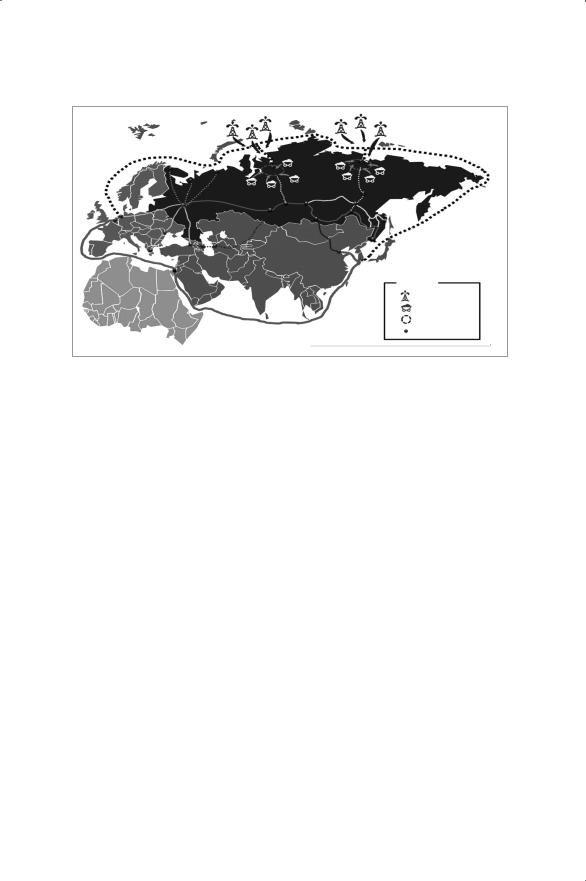
110 |
Patterns of Arctic Investment |
Northern sea route
Tiksi
Dudiaka
Suez route
TSR |
|
BAM |
|
|
|
|
Moscow |
|
TSR |
|
|
|
|
|
|
|
Vanino |
|||
|
|
|
|
|||
|
|
TMGR |
|
|
|
|
|
|
|
Vladvostok |
|||
|
|
|
Busan |
|||
Suez canal |
|
|
|
|
Legend |
|
|
|
|
|
|
|
|
|
|
|
|
|
Oil & Gas (offshore) |
|
Suez |
route |
|
|
|
Mining (onshore) |
|
|
|
|
|
Logistics park |
||
|
|
|
|
|
||
|
|
|
|
|
port |
|
|
|
|
|
|
|
|
Figure I-15. Concept of accessible logistics network on and offshore in Russian Arctic
provide East Asia and Europe with useful transport routes via the TransSiberian Railway (TSR) as well as the NSR, as shown in Figure I-15.
Apart from physical infrastructure, commercial Arctic shipping needs to address other requirements shown in the Arctic Marine Transportation System (AMTS) by the Norwegian expert Bjørn Gunnarsson. This system consists of four sectors, as follows:
a) Physical infrastructure such as adequate ports and terminals with deep draft access, cargo handling and passenger/crew facilities and the provision of refuge for ships, b) information infrastructure such as navigational charts with updated hydrographic and shoreline mapping data, aids to navigation and real-time navigation information, marine weather and sea ice forecasts, proper communication systems and vessel traffic monitoring and reporting systems, c) response services such as services of icebreakers for vessel escorts, search and rescue and emergency response, oil spill prevention and preparedness and available response technologies to clean up oil and other hazardous wastes spilled at sea, and d) Arctic vessels, including a fleet of ice-strengthened cargo ships and specialized vessels operating in the harsh Arctic environment, possibly on a year-round basis.
This list will apply to South Korea’s case if it gives serious consideration

Commentaries |
111 |
to entering into the NSR energy resource logistics market.
WHO ARE THE INVESTORS IN ARCTIC ONSHORE AND OFFSHORE RESOURCE DEVELOPMENT?
The development of Arctic resources will require huge investments in related infrastructure development. The question is: who will invest? In general, development of infrastructure abroad is conducted by government funding, private investments, and private-public partnerships (PPP).
In some cases, especially those involving infrastructure development for less developed countries by developed countries, official development assistance (ODA) may be available. Coastal nations in the Arctic region, however, do not meet the requirements for ODA investments. As a result, the next-best option for investment will be a combination of government and private investment efforts.
But the problem is, as Valeriy Kryukov mentions, that the lack of transparency in foreign direct investment regulations and complex ownership problems in Russia make it difficult to find appropriate ways to safeguard investments. An alternative may be investments by international development banks. But the problem still remains because international development banks such as World Bank and Asian Development Bank need their monetary sources to assist LDCs. Even in the case of a monetary source being secured, they would face limitations arising from the institutions’ basic roles. So for infrastructure development in the Arctic region, the Asian Infrastructure Investment Bank (AIIB), recently initiated by China, seems to have potential for funding.2 Additionally, the tentatively named Arctic Development Bank, which will be able to establish joint efforts of Arctic coastal nations and Arctic user countries, can play a significant role in raising funds for Arctic infrastructure development. However, in both cases, the prospect of conflicting interests in stakeholder countries demands more consideration in order to make such an institution work well.
ARE ECONOMIC BENEFITS FROM ARCTIC RESOURCE DEVELOPMENT POSSIBLE?
Eventually, the value of Arctic natural resources depends on the question

112 |
Patterns of Arctic Investment |
of whether the development and extraction of such resources would be profitable. Energy resource development in the region must address a number of factors such as environmental risks, the social safety of Arctic aboriginal communities, costs entailed by infrastructure development and building and maintaining icebreakers, and price fluctuations braising from world energy markets. Such cost factors will be reflected in transit charges imposed by the Russian government. Moreover, the ups and downs of resource prices can lead to irregularity in the NSR’s commercial use. In addition, a lack of preparedness in terms of institutions and administration and unclear private ownership problems may interrupt the smooth entry of foreign capital into Arctic energy development. Thus, it seems doubtful if energy resources in the Arctic–again especially in the Russian Arctic–will emerge in the world energy resource market.
HOW CAN THE PROBLEM OF COMMERCIALIZING THE ARCTIC’S NATURAL RESOURCES BE SOLVED?
In order to solve the cost problems involved in the development of natural resources in the Russian Arctic, technological progress regarding the prevention of oil spills, ship building, resource extraction, and related infrastructure development will be needed to reduce costs. Furthermore, effective ways to maintain the price of commodities produced in the Russian Arctic will be needed. One of the prime tasks in this respect will be setting up a stable price structure that is immune to seasonal fluctuations.
In this regard, the option of constructing a transshipment hub like the Zeebrugge LNG terminal in the Yamal LNG project deserves attention. The advantage of such an approach is that companies can use such a transshipment hub to store products in order to sell them at a favorable time, minimizing the limitations of using the NSR in the winter season with their inventories. Moreover, this sort of facility can support value-added activities such as the dehydration of mineral products and desulfurization and refinement of petroleum (see Figure I-16).
In this respect, the South Korean government is examining the future role of Ulsan Port, one of the largest ports in South Korea in terms of liquid cargo, as an international hub for the transshipment hub of energy resource cargos in East Asia.3 Ports in the Russian Far East and on Japan’s West Coast would likely join in competition with Ulsan Port to play a leading
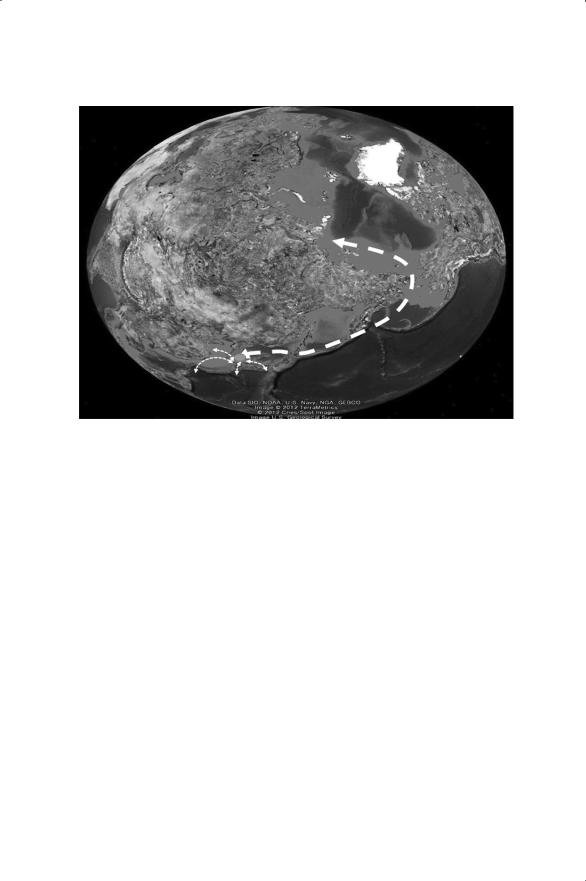
Commentaries |
113 |
|
|
|
|
Figure I-16. Transshipment hub in East Asia
role in this realm.
To facilitate the business activities surrounding Arctic natural resource development and related commercial maritime shipping via the NSR, a concerted effort will be needed. For Russia, it is essential to improve legal systems so they are more favorable for attracting foreign direct investment, especially for private investments, and to introduce ecofriendly and aboriginal-friendly natural resource development rules. Along with the Russian efforts, cooperative international efforts will be needed for the joint development of a logistics infrastructure in the Arctic region, development of transshipment ports to improve demand and supply flows and create added value, construction of storage facilities, R&D efforts related to shipbuilding technology, and energy resource and mineral resource development. At the same time, and simultaneously, the consolidation of international governance for the sustainable development and use of resources will be essential for the commercialization of Arctic natural resources and vitalization of the NSR.
